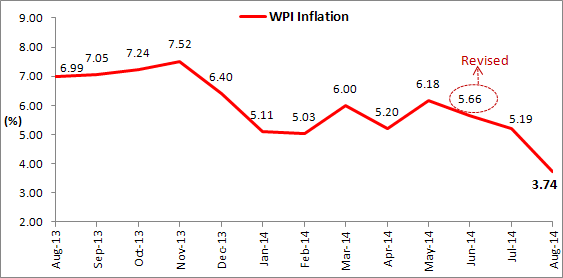
Impact 
Inflation measured by the movement of Wholesale Price Index (WPI) eased to 3.74% in August 2014 placing it at 5-year low. This was a sharp fall from 5.19% recorded in July 2014 and even 6.99% in August 2013.
A reduction in prices across categories led to WPI inflation mellow down further. Inflation in food articles, declined to 5.15% in August 2014 from 8.43% in the month prior. Likewise, prices of primary articles to reported a decline to 3.89% from 6.78% in the month prior... and so did fuel & power inflation which eased to 4.57% in August 2014 from 7.40% in month prior. Similarly, sluggish price rise in manufactured products (which has a weightage of nearly 65%) and slower growth in energy prices (which has weightage of nearly 15%), kept a lid on WPI inflation.
WPI inflation mellowed down further...

Data released on September 15, 2014
(Source: Office of the Economic Advisor, PersonalFN Research)
The retail inflation measured by the movement of Consumer Price Index (CPI) for the month of August too came a tad lower at 7.80% in August 2014 as against 7.96% recorded in July 2014.
Hard Facts...
| Category |
Weight in WPI |
Weight in CPI |
WPI |
CPI |
| Food articles |
14.34 |
42.71 |
5.15% |
9.42% |
| Vegetables |
1.74 |
5.44 |
-4.88% |
15.15% |
| Fruits |
2.11 |
1.89 |
20.31% |
24.27% |
| Fuel and Power |
14.91 |
9.49 |
4.54% |
4.15% |
| Egg, fish and meat |
2.41 |
2.89 |
-5.87% |
7.71% |
| Cereals |
3.37 |
14.59 |
3.70% |
7.39% |
(Source: CSO, Office of the Economic Advisor, PersonalFN Research)
The stark difference between the WPI and the CPI inflation suggests that, although industrial inflation has cooled off, retail inflation remains high. Consumer food prices dominate the composition of CPI index. While food price inflation at the wholesale level has moderated (to 5.15%), it has remained high at the retail level (at 9.42%). This suggests that, retailers have been benefiting from the fall in prices at wholesale markets, but benefit isn't getting passed on to consumers at retail level. This is strikingly visible in case of vegetables, fruits and protein based items (such as egg, fish and meat); where there is actually a price decline at wholesale markets but retail prices have remained firm. Possibly taking advantage of delayed start of monsoon, hoarders have managed to keep retail prices up.
On the other hand, fuel & power prices have witnessed some easing. You see, softening in international crude oil prices at international markets have been a positive in this respect.
Impact on markets
Both equity and debt markets have remained neutral despite fall in the inflation. This is partially because of sliding IIP growth and also because unlikeliness of a policy rate cut by the Reserve Bank of India (RBI) in the 4th bi-monthly monetary policy statement for 2014-15 (scheduled on September 30, 2014). Steady inflows of foreign capital in both debt and equity are keeping markets firm. However, tracking weak global sentiment ahead of an important meeting of the U.S. Federal Reserve (Fed), Indian markets have also seen a mild sell-off. Equity indices have come off from their highs while bond yields have firmed up a bit.
What to expect?
RBI Governor, Dr Raghuram Rajan has already clarified that it is unlikely that RBI would lower policy rates at its next monetary policy review meet. He is of the opinion that, it would make a little sense to cut rates in a hurry and then see inflation shooting up again. The RBI is expected to wait a while and would like to see further drop in inflation at a consistent pace before it announces a rate cut.
PersonalFN is of the view that, the sustainability of this data needs to be judged in time to come. It remains crucial to be seen whether food price inflation at retail level, moderates going forward. Strong revival in monsoon may ease inflation worries and inflation expectation may go down a bit, resulting in fall in retail inflation. Likewise, trend of international crude oil prices needs to be watched.
Speaking about the impact of forthcoming monetary policy, markets have now factored in status quo. Therefore unless rates are increased or lowered surprisingly, markets may react neutrally to any announcement of RBI. The guidance of the RBI may be tracked closely though.
Add Comments
| Comments |
naren_kotecha@yahoo.com
Sep 21, 2014
Unless we have a strong social security scheme, cutting down interest rate will be highly damaging to those retirees who have no wards supporting them and are living only on Interest Income....alternately RBI can try increasing 0.5% extra to a higher figure for senior citizens |
1